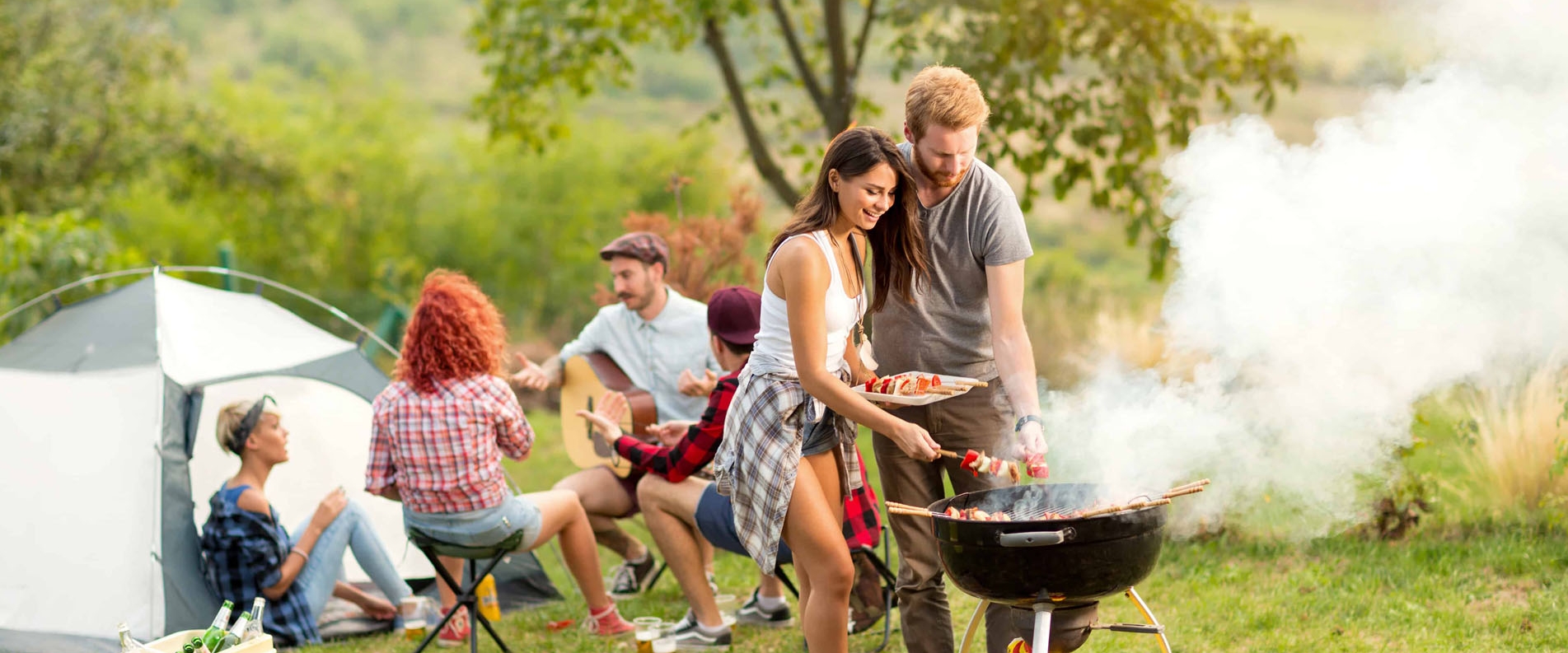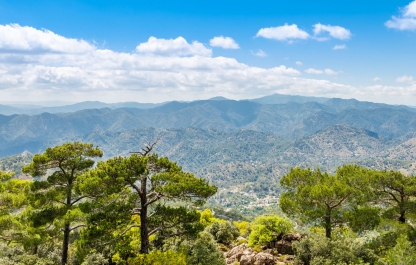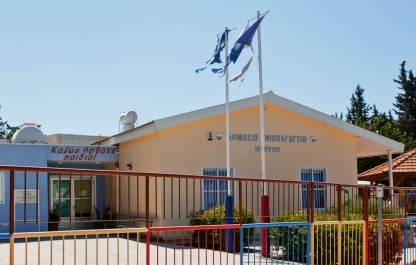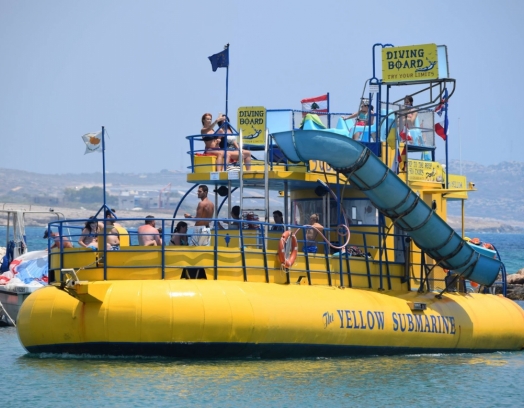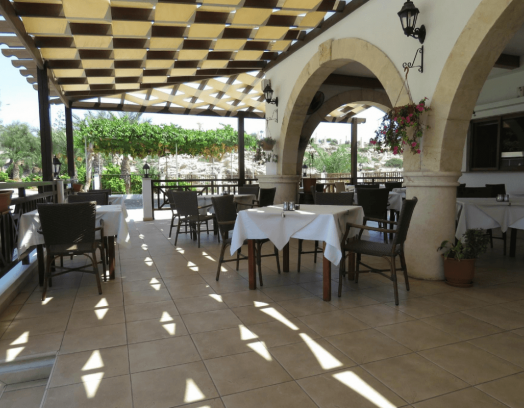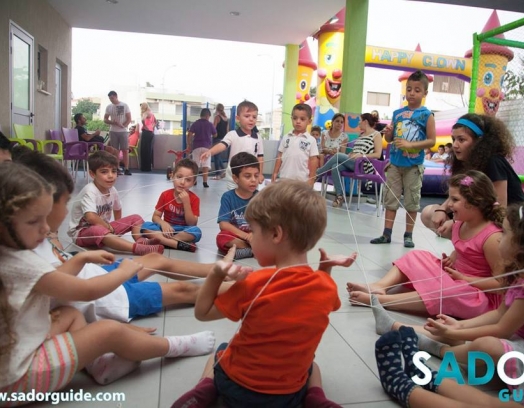Cypriots may have a reputation for being freedom-loving, slightly chaotic, and not the most work-obsessed people on earth. But when it comes to their leisure time, you’d be surprised how impressively organised things can get. In fact, Cyprus boasts one of the most thoughtfully structured networks of picnic areas and campsites I’ve seen — and I’ve travelled through nearly 50 countries. If your idea of a holiday includes trees, firewood, and grilled halloumi under the sky, you’re in the right place.
In this guide, we’ll explain what exactly a picnic area is, how it differs from a campsite, and where you can find the best spots to unwind across the island.
Let’s start with a broader picture. Nature is a complex subject in Cyprus. Officially, the island treats its wilderness like a national treasure. Felling a tree is considered far more criminal than hunting small game. Collecting firewood is forbidden, and don’t even think about starting a fire in a non-designated area — doing so might land you in court or even behind bars. Fire hazards are a major issue here, and the authorities take prevention very seriously.
Walk any official forest trail, and you’ll notice that trees are tagged and protected, with saplings shielded from the sun by hand-built barriers. The image is idyllic: Cyprus and its nature living in peaceful harmony. But drive a little off the tourist paths, and the other side becomes visible — heaps of garbage, campfires scorched into the ground, and spent shotgun cartridges scattered like confetti. Despite the ban, mouflon hunting supposedly still happens, just not in broad daylight. Songbirds are trapped en masse for culinary purposes, and come autumn, entire hillsides are ransacked by stick-wielding mushroom hunters digging for prized saffron milk cap), often damaging delicate forest ecosystems.
So what does all this have to do with picnic areas? Simply this: enjoying nature in Cyprus outside of designated zones is not exactly straightforward. But in official picnic sites and organised campsites, everything’s above board. These places are the government’s way of encouraging people to enjoy the outdoors without damaging it — a “good cop” strategy, you might say. You’re welcome to barbecue, relax, even camp — all within the safety and legality of a managed environment.
In many countries, the line between a picnic site and a campsite is blurred — they’re often one and the same. In Cyprus, however, everything is sharply defined. Picnic areas are usually free and designed for daytime use only — overnight stays are strictly prohibited. Campsites, on the other hand, always charge a fee and are specifically intended for overnight accommodation.
Picnic areas across the island follow a consistent layout. At their core is a sturdy stone platform topped with a metal hood, shielding it from the harsh Mediterranean sun. This spot becomes the communal grill base — visitors bring their own barbecues and place them here. There’s a built-in dip for discarding used charcoal, and occasionally, entire animals are roasted on the spot. However, you won’t typically find fixed grills — it’s a bring-your-own-fire kind of place.
Surrounding this “culinary altar” is an abundance of wooden tables and benches — sometimes enough to host your own Oktoberfest. Nearly all picnic areas include modest children’s play zones: a sandbox, a swing or two, and maybe a climbing frame or slide to keep little ones busy.
Facilities also include drinking water, toilets, and bins — ensuring the areas stay clean and visitor-friendly.
Campsites offer all the basics of picnic areas, with a few key upgrades: hot showers, tent pitches (or even pre-set tents), and in many cases, space for camper vans or caravans — though these come with additional costs. Larger sites may include dining halls or restaurants, and while not every campsite has its own picnic space, there’s usually one nearby, often just across the road.
In Cyprus, nature-lovers tend to gravitate toward two major attractions: the mountains and the sea. Both are ideal for camping and picnicking from mid-spring to mid-autumn. Winter, however, brings snow and freezing temperatures to the mountains, and the beaches become chilly and windswept — not exactly picnic weather, unless you enjoy braving 19°C waters.
So, let’s explore the island region by region to discover the top spots. We won’t list every single picnic site — there are over forty, and many are virtually identical in setup and scenery. Instead, we’ll highlight the most scenic, well-equipped, or unusual locations worth the detour.
As for campsites, there aren’t many — which makes it easier to cover each one in detail.
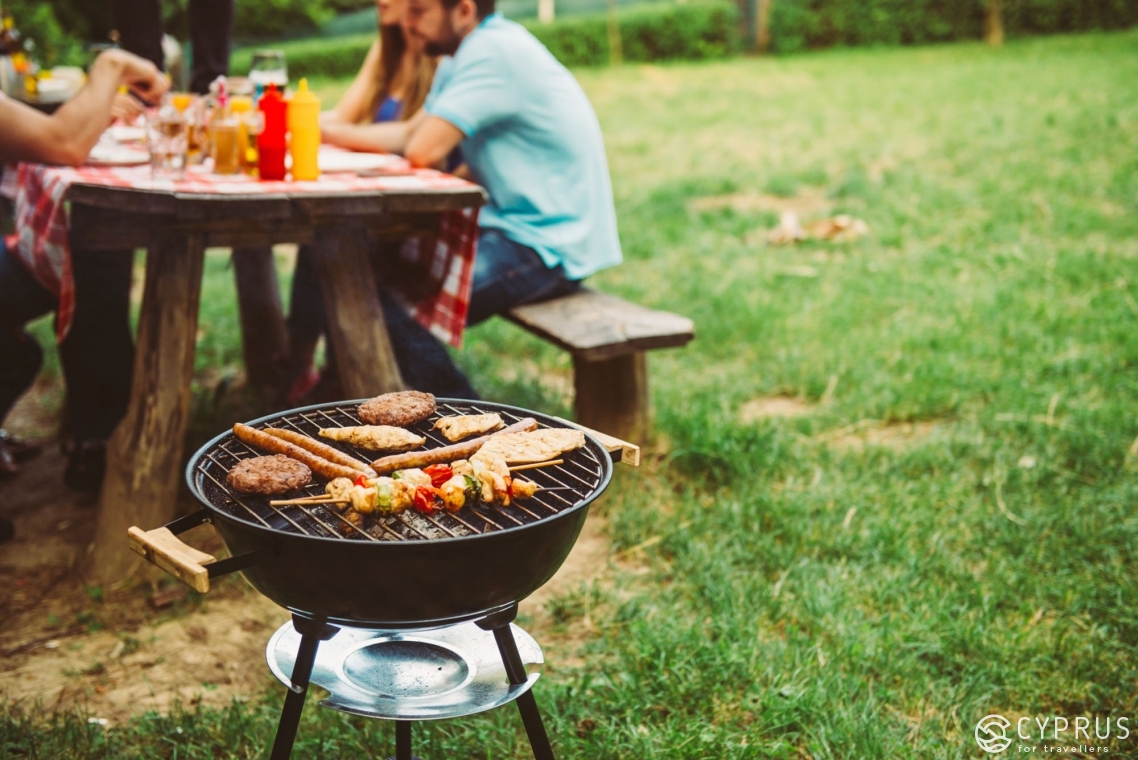
Nicosia District
While the city of Nicosia
itself lies inland, the wider district actually reaches the sea — albeit only in a small stretch on the island’s northern coast. This seaside strip is rarely visited by tourists, which helps preserve its raw, authentic charm. The beaches here differ noticeably from the rest of the island — softer sand, unique water temperature, and an untouched atmosphere.
Where Nicosia District really shines, though, is in its mountainous terrain. It offers a rich array of scenic and diverse landscapes, making it a paradise for outdoor enthusiasts.
Picnic Areas in Nicosia:
Kambos tou Livadiou Picnic Area
This is one of the highest-altitude picnic spots in Cyprus — which makes it ideal for cool, breezy barbecues even during the summer heat. The mountain air here is crisp and pine-scented, and despite how picturesque the area is, it remains surprisingly uncrowded. Why it doesn’t draw more visitors is a mystery — especially given the smooth access road and peaceful setting.
Another rarity is the presence of lush green meadows. On an island where sun-scorched rock and thorny brush dominate the landscape, stumbling across a vivid patch of grass feels almost magical. It’s likely the only meadow of this size and freshness that isn’t actively cultivated — a true visual treat.
Platania Picnic Site
Platania is vast — a broad, flat clearing hugged by forested mountain slopes. Unlike many smaller sites, this one feels expansive and atmospheric. Towering pine and oak trees offer dappled shade, and even during the high season, it rarely feels crowded.
A small restaurant and forest ranger station sit at the edge of the area. While the restaurant might not compete with a well-grilled souvlaki, it’s a nice touch if you're passing through. One thing to note: there’s a main road close by, but it’s elevated and buffered by dense forest, so it doesn't disturb the calm.
This spot is also a favorite during mushroom season. In autumn, edible fungi sprout right by the benches. Still, with the road nearby, foraging might not be the safest idea.
There's no water access at Platania — but the towering trees more than make up for it.
Athalassa Picnic Site
Athalassa is unique — the only picnic area on our list located inside Nicosia proper. Set within an enormous forest park that spans roughly one-tenth of the city’s area, it provides a much-needed natural escape. The park features a lake, playgrounds, jogging trails, and open-air gyms.
The picnic zone itself is tucked away in a eucalyptus grove at the park’s eastern edge, slightly removed from the main crowds. Its biggest advantage is accessibility: a motorway leads you almost directly to the entrance.
Don’t expect lakeside lounging though — reaching the water involves a bit of a walk.
Campsites in Nicosia Area:
Platania Camping Site
Season: Open from May to September
Fee: €3 per tent spot
Perched 1,100 meters above sea level, this campsite offers excellent facilities: two sanitation blocks with showers and hot water, a shared kitchen area, and a small shop-style dining room selling basic supplies.
Though surrounded on three sides by a fairly active road, the thick pine forest and higher road elevation buffer most of the noise. The camp itself can host up to 600 people and feels spacious — at least in spirit. In practice, dense woodland, roads, and steep hills create a sense of enclosure. So while it may look expansive, don’t expect long carefree strolls unless you’re ready for some uphill climbing.
There’s no direct water access here, but the forest’s beauty is undeniable. Chestnut trees are scattered throughout — they may look edible, but appearances deceive. One bite will remind you they’re ornamental at best.
Larnaca District
When it comes to enjoying nature through campsites or picnic areas, Larnaca District doesn’t quite lead the charge. The region is blessed with some of Cyprus’s most stunning beaches — soft white sand, transparent turquoise waters, and tropical palms — but nearly all of this coastal beauty has been claimed by hotels and resorts. There’s very little of it left untouched, and even less adapted for quiet outdoor escapes.
As for mountains, Larnaca is mostly home to rolling foothills, save for a modest highland patch near the village of Odou. There are no dedicated campsites or mountainous picnic zones to speak of — but to say Larnaca offers nothing would be unfair.
Let’s take a look at what is available.
Picnic areas in Larnaca:
Kornos Picnic Area
By Larnaca standards, this forested picnic site is already a decent find. While not particularly distinctive, it’s pleasant and well-frequented — mainly by locals. Despite its proximity to a main road, the spot remains relatively peaceful, thanks to the surrounding greenery. A few of the tables come equipped with metal shade roofs to shield you from the blazing sun. In short, a serviceable option for a quick barbecue escape.
Rizodelia Picniс Area
Set in what’s called the Rizodelia Forest just outside Larnaca, this area is less “forest” and more a patch of hard clay soil dotted with spindly young pines. It resembles the Limassol Forest Park or many green zones within Nicosia — functional, but far from scenic. Still, when compared to a barren lot behind your house, it does the job. For Larnaca, it’s passable — though don’t expect too much.
Oroklini Park and View Point
Search “picnic areas in Larnaca” on Google, and you’ll only see the two options above. I’ve combed through dozens of guides and listicles — none of them mention any others. But I know at least one more. And it just might be the best.
Oroklini Park is a small, elevated green space overlooking Larnaca with impressive panoramic views. The nature here isn’t overwhelming — no thick forest or high-altitude breeze — but the scenery and atmosphere make up for it. You’ll find picnic tables and benches scattered across the area. Google Maps sometimes marks it as a “camping site,” but in all my visits, I’ve never seen a single tent.
This place is a hidden gem. It’s quiet, breezy, and often deserted — perfect for a peaceful outdoor meal with a view.
Campsites in Larnaca:
Unfortunately, Larnaca comes up empty in this department. While you might find online mentions of campsites near Cape Greco or Ayia Napa, I’ve never seen any evidence on the ground — no signs, no tents, no infrastructure.
So we’ll call it: no active campsites in Larnaca District.
Limassol District
Limassol may be the smallest district in terms of land area, but it offers a diverse mix of natural beauty — from rugged coastlines to mountain peaks. While large sections of the Limassol coastline are occupied by British military bases and hotel resorts, there are still stretches of unspoiled beach and secluded spots for nature lovers. However, when it comes to organised seaside camping, options are limited: only one official coastal campsite exists. While spontaneous camping does occur — particularly on Lady’s Mile Beach — it falls into the category of unregulated tourism.
The real natural treasures of Limassol lie inland. This region boasts the southern slopes of the Troodos Mountains, complete with rivers, waterfalls, scenic overlooks, and the island’s highest peak: Mount Olympus.
Picnic areas in Limassol:
Trooditissa Picnic Area
Although Trooditissa is primarily known as a monastery
(and a river), just a few metres away you'll find a well-frequented picnic site. Don’t expect monks or pilgrims here — the area is mostly visited by Limassol locals looking to relax in nature.
Trooditissa Picnic Area stands out for two main reasons:
First, a small river runs directly through the site and continues to flow even during Cyprus’ dry summers. It’s narrow and shallow where the picnic tables are, but a short walk upstream reveals natural rock pools that are deep enough for a refreshing dip — provided you’re a bit agile.
Second, this spot boasts one of the most spectacular panoramic views in Cyprus — perhaps even one of the best you’ll find anywhere. Though it sits at a modest altitude of 1300 metres, the site lies at the upper edge of a valley that unfolds all the way to the sea. From here, you can admire rolling mountains, scattered villages, and imagine the nearby roar of Chantara waterfall below (though it’s not visible from the site).
Despite the altitude, summer heat can still be felt. Thankfully, the dense tree cover and the cool river help keep the area comfortable, even in August.
Expect crowds here. The terrain amplifies sound, so music, voices, and laughter bounce across the valley. There’s also a bungee jump base nearby — not ideal if you're seeking a peaceful retreat.
Limassol Forest Picnic Site
This picnic site is extremely popular, largely because it’s one of the closest forest barbecue areas to Limassol city. Yes, there is another one technically within city limits (Limassol Forest Park), but that one lacks charm.
Located about 20 km from the city at an altitude of 600 metres, this site is known for its lively (and noisy) atmosphere. Expect music, shouting children, and the occasional accident followed by crying. It’s especially popular with Limassol’s Russian-speaking community and their extended Greek families.
The area doesn’t feature any water sources, and despite decent tree coverage, it tends to feel quite stuffy in the summer. Visually, the site is nothing extraordinary — just a standard forest clearing.
Why mention it? Because of its popularity and accessibility. Still, if you’re already willing to drive 20 km, adding another 10 to reach Trooditissa (just 30 km from the city) might be worth it — for the views, cooler air, and natural river.
Mesa Potamos (Argolachania) Picnic Site
Set deep in the Troodos Mountains, this site is surrounded by dense forest and accessible only via a quiet road. While the main tourist routes run a few kilometres to either side, the road to Mesa Potamos Picnic Site remains almost eerily deserted.
Along the way, the only point of interest is the Monastery of St. John the Forerunner of Mesa Potamos — much quieter than its famous counterpart, Kykkos Monastery. That tranquillity carries over to the picnic site itself.
Admittedly, visitor numbers have increased in recent years, especially post-COVID, and you might now encounter a full car park on weekends. But during my last visit, the place was deserted. If you do go, let our editorial team know how things stand these days.
Highlights include a gentle forest river that passes right by the picnic tables and transforms into a small, accessible waterfall about 200 metres downstream — worth a walk. The whole site is nestled in the heart of nature, far from villages and highways.
One caveat: the picnic area sits on a slope, and navigating from one end to the other requires some uphill walking. Keep a close eye on children, as it’s easy for them to slip or wander off down the incline.
Camping in Limassol Area:
Troodos Camping Site
Open: April – September
Cost: €5 per tent spot
Situated at 1600 metres above sea level, this is the highest alpine campsite in Cyprus — a real retreat among black pine trees, which only grow at such elevations. The air is crisp, the views are spectacular, and the village of Troodos (with cafés and small shops) is just a short walk away.
Despite its modest capacity (up to 65 guests), the site is well-maintained and highly praised by visitors for its cleanliness and thoughtful organisation. Facilities include toilets, showers, drinking water, barbecue areas, and a designated dining area with tables. There’s also an on-site restaurant for those who don’t want to cook.
Please note: pets are not allowed.
Kampi tou Kalogyrou Camping Site
Open: April – October
Cost: €2 per tent per night
This midsize campsite lies at 1500 metres above sea level and offers all the essentials: toilets, showers, drinking water, barbecue stations, and picnic tables. While it’s similar in structure to Platania Camping Site, it lacks oak trees and is slightly smaller in scale.
Set between a forested slope and a steep drop-off, the area feels remote despite being near the main road. A picnic area lies just across from the campsite, and several hiking trails offer panoramic views. There is no access to natural water sources.
Governor's (Kalymnos) Beach Camping Site
Open: Year-round
Cost: €2.50 per person + €3.40 per tent
One of the few coastal campsites in Cyprus, Governor’s Beach Camping Site is just 20 km from Limassol — an easy weekend escape. It can accommodate up to 360 people and features toilets, showers, barbecue pits, benches, a play area, car parking, and even a small market.
While proximity is the main appeal, the seaside itself isn’t the island’s most spectacular. The cliffs are small, access to the water is tricky, and the surrounding area is well developed — it feels more like a holiday complex than a remote nature getaway. Interestingly, a quarter of the campers here are long-term residents renting space annually.
Adventure Mountain Park
Open: Year-round
Cost: €6 per person per night
A lesser-known option, this private campsite is nestled inside Adventure Mountain Park — a forested complex offering activities like paintball, archery, rock climbing, and orienteering, plus a restaurant. Although not listed in official directories, it offers a peaceful camping experience separated from the activity zones.
The campsite sits on a forested slope just above the main park. The surroundings are picturesque and quiet, perfect for enjoying nature. Just a few steps away is the hiking trail to Madari peak — offering arguably the most stunning panoramic views in Cyprus.
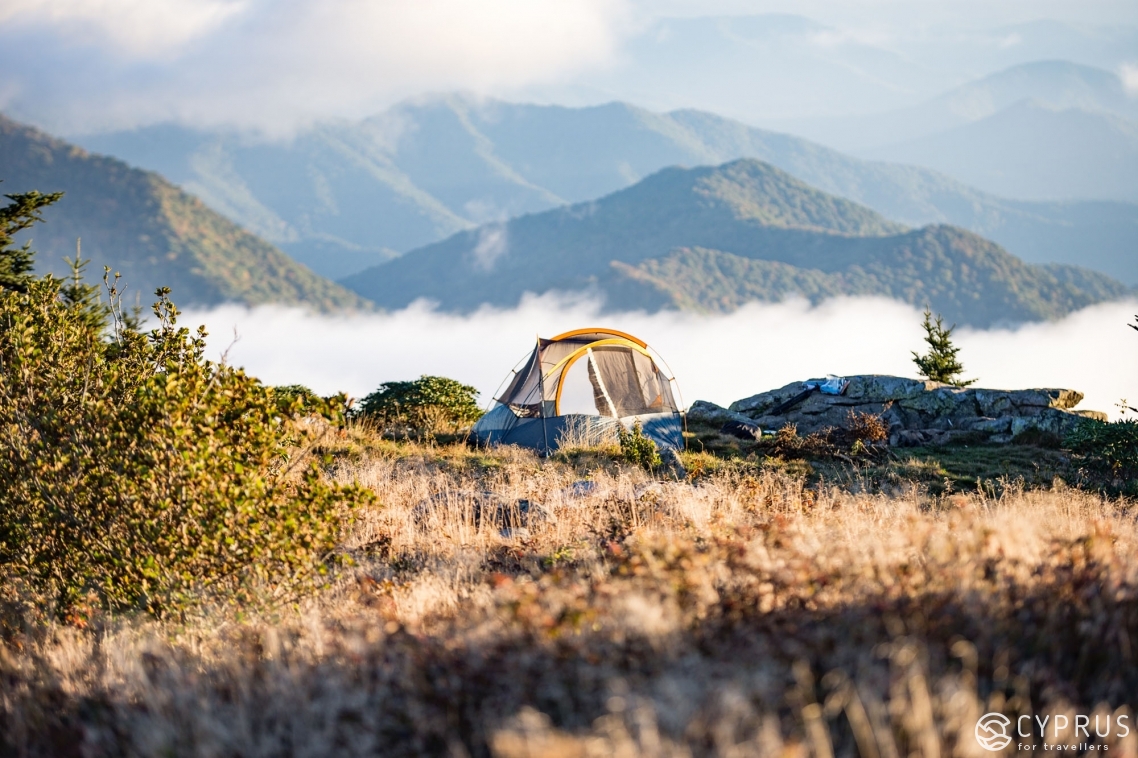
Paphos District
The Paphos District offers one of the most diverse and picturesque settings for picnicking in Cyprus. With its untouched coastline, national park peninsula, and expansive forested mountains, it combines sea, forest, and highlands into a single idyllic region. Here are three of the best picnic areas in the district — each with its own unique charm.
Picnic areas in Paphos:
Prodromos Picnic Area
Location: Near Prodromos Reservoir, northern Troodos slopes
Altitude: ~1600 metres
In the author’s opinion — and rightly so — this might be the best picnic site in all of Cyprus. Why? First, it’s one of the few places where your picnic table comes with a view of a mountain reservoir. True, it’s not for swimming (or maybe it is, but no one does), yet its presence adds a cooling breeze and paints the surroundings with a serene beauty — especially when viewed at sunset with a beer in hand.
Aside from the view, the site features a walkable patch of forest — a rarity in Cyprus, where most hiking trails require serious effort and sturdy boots. Add to that the ancient, majestic pine trees and the panoramic vista of Troodos’s northern face — and you’ve got yourself a proper alpine escape.
The only drawback: the secret’s out. Prodromos Picnic Area is a crowd magnet, especially in summer and post-pandemic seasons. Finding a free table can feel like a quest of its own.
Mavralis Picnic Site
Location: Northern coast, near Polis
Altitude: Sea level
At first glance, Mavralis may seem like a basic setup — just a green clearing, warm sea, tables, and grills. But that’s precisely what makes it special. It’s nearly impossible to find another place in Cyprus where you can light a barbecue and picnic just steps from the shoreline, with no steep descent or barriers between you and the sea.
Locals often consider this one of the best coastal picnic areas in the country. Its simplicity and accessibility have made it a favourite for generations. If you want the sea, the shade, and the sizzle of food on a grill — this is your spot.
Picnic Site in Peyia
Location: Hillside above Peyia village
Altitude: ~200 metres
Perched on a hillside with sweeping views over Paphos and the sea, the Peyia Picnic Site is all about the vista. The spot is green, breezy, and easily reachable from the city, making it an ideal option for a spontaneous weekend lunch.
While it doesn’t offer any extraordinary facilities, the natural charm and stunning outlook make up for it. The perfect backdrop for a laid-back afternoon.
Camping in Paphos Area:
The Paphos region is a paradise for nature lovers and outdoor adventurers. From lush forests to warm seas and quiet mountain slopes, it offers a unique blend of scenery for campers. Below is a selection of campsites in Paphos — from the country’s largest organised site to remote forest hideaways.
Polis Chrysochous Camping Site
Location: Polis, near the beach
Operating period: March – October
Cost: From €4 per person, extras for tent, electricity, etc.
Capacity: Up to 700 guests
The largest campsite in Cyprus, Polis Chrysochous Camping Site is located in a shady eucalyptus forest right by the sea. It’s equipped with everything you need: toilets, showers, power sockets, wooden tables and benches, a bar, a beach volleyball court, parking and barbecue zones.
The nearby beaches are cosy, often with warmer-than-average seawater and occasional big waves — a delight for some, a drawback for others. The popularity of the site has grown significantly, especially among locals, making it quite crowded in peak summer months. Expect plenty of families, dogs, and lively evenings.
Downsides? The bar is pricey (think €6 for a small salad), and during high season, it’s more of a festival than a nature escape. A recent earthquake also damaged some facilities — the volleyball court may still be out of action.
Stavros tis Psokas Camping Site
Location: Paphos Forest
Operating period: March – October
Cost: From €2 per day
Capacity: Up to 150 guests
Operates from March through October.
Costs from 2 euro per day.
Nestled deep in the wilds of the Paphos forest, this small and remote campsite is a true back-to-nature option. It lies about 45 km from Paphos and over 100 km from Limassol. Misdirections are common on Google Maps, so it's best to double-check coordinates before setting off.
Facilities include toilets, showers, two small kitchens, barbecue areas, and a nearby café-restaurant. However, with no tourist landmarks or villages nearby, this site is all about isolation, forest silence, and a touch of wilderness.
A nearby mouflon reserve adds a unique twist for nature enthusiasts. With limited coolness due to its relatively low altitude (900 m), this spot is best enjoyed in spring or autumn.
Feggari Camping Site
Exact location unknown. Approximate location: here.
Location: Approximate — near Coral Bay
Operating period: All year round
Cost: Unknown
Capacity: Around 50 people
Little is known for certain about Feggari Camping Site, but it’s mentioned often enough to earn a place on this list. While geolocation data online is unreliable, you might track it down with a local tip once in Coral Bay.
Despite its size, Feggari packs in plenty: toilets, showers with hot water, electricity, a mini kitchen, barbecue facilities, a bar, a restaurant, and even Wi-Fi. Situated near one of the busiest nightlife spots on the island, it offers a strange blend of rustic camping with the vibrant energy of Coral Bay — think of it as a laid-back alternative to nearby resorts.
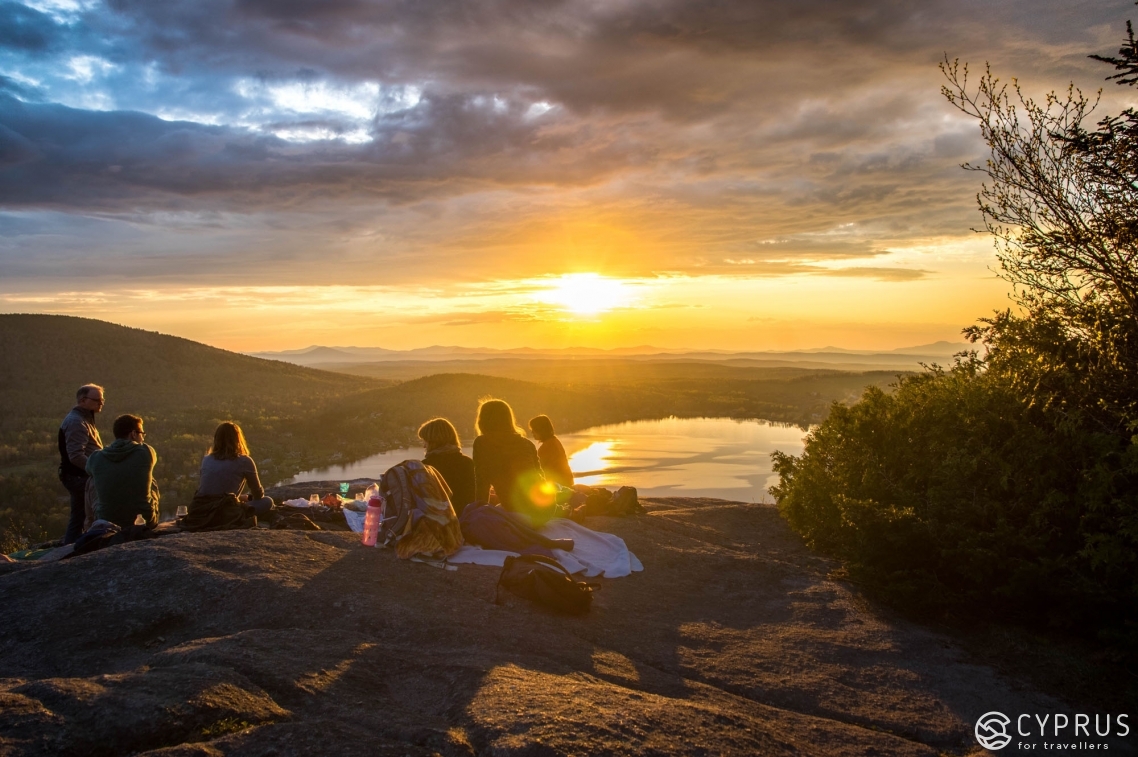
You can find a lot of reviews for campsites and picnic areas on the internet, but we’ve made our own. In it, we’ve tried to add as much important information as possible for those getting ready to take some downtime in the outdoors. We’ve also included several sites where it’s hard to find any information about them. We hope our review was interesting and came in handy.
Wishing you a splendid holiday!

